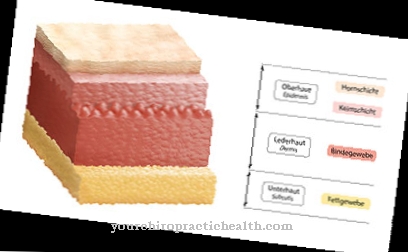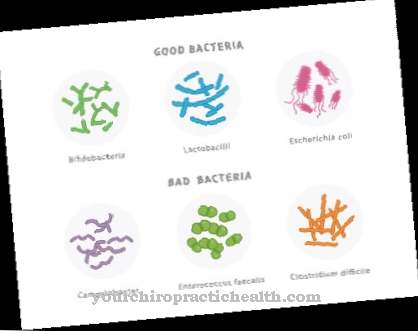In the Polymyalgia rheumatica (PMR), or short Polymyalgia, it is a rheumatic inflammatory disease that is accompanied by severe pain in the neck and shoulders, as well as in the thighs and pelvic area. Mainly older people suffer from polymyalgia rheumatica.
What is polymyalgia rheumatica?

© agenturfotografin - stock.adobe.com
The muscle pain in the Polymyalgia rheumatica occur mainly in the morning and in batches. The mobility of the body can be severely restricted due to pain. Similar to a flu-like infection, the sick complain of a poor general condition.
In some cases, polymyalgia rheumatica also inflames large blood vessels, especially of the head, such as B. the temporal artery. If the treatment is not timely, the inflamed arteries can become blocked. If the blood supply to the eye is affected, the sick person becomes blind. In contrast to other muscle diseases, polymyalgia rheumatica does not restrict the strength of the muscles.
Every year up to 40,000 people in Germany develop polymyalgia rheumatica, 80% of them women. People under the age of 50 are less often affected, and those over 60 are particularly severely affected.
causes
The causes of the Polymyalgia rheumatica are still largely unclear. However, as with other rheumatic diseases, the immune system is apparently misdirected.
Age-related malfunctions of the body's own immune cells probably lead to the production of so-called cytokines (messenger substances consisting of certain proteins) which are directed against the body and thus trigger inflammation. Polymyalgia rheumatica is therefore a so-called autoimmune disease.
The additional inflammation of blood vessels, called vasculitis, may also be due to a malfunctioning immune system, which mistakenly attacks cells in your own body. The inflammation of blood vessels on the head is called cranial arteritis, which also occurs in half of people with polymyalgia rheumatica.
Symptoms, ailments & signs
The main symptom of the autoimmune disease polymyalgia rheumatica is pain in the muscles of the extremities. These pains always occur symmetrically, so that both sides are always affected. The pain symptoms in patients with polymyalgia rheumatica are preferred in the area of the hip muscles, the shoulder muscles and the neck muscles. Characteristically, the muscle pain is much stronger at night than during the day.
Often patients also report a sudden, clearly noticeable morning stiffness. The painful stiffness of the muscles in the pelvic girdle area and / or shoulder area can lead to complete inability to move. Some people with polymyalgia rheumatica also complain of a general feeling of illness, such as can occur with the flu or a cold.
Some of the patients develop anemia (anemia) as the disease progresses. This is associated with complaints such as tiredness, exhaustion, poor concentration or susceptibility to infections. Anemic patients are also noticeably pale, and the dermis of the eye (sclera) are pale.
The rarer complaints include night sweats, loss of appetite and depressive moods. Synovitis also occurs in a fifth of those affected. This inflammation of the synovial membrane (membrana synovialis) also occurs symmetrically and is associated with joint pain and restricted mobility.
Diagnosis & course
The attending physician becomes his Polymyalgia rheumatica-Diagnosis is based on a physical examination of the patient, medical history and the results of the laboratory examination.
Symptoms of polymyalgia rheumatica can include neck, shoulder, upper arm and pelvic pain, weight loss, sweating, joint pain and depression. If a polymyalgia rheumatica patient complains of impaired vision or a headache, this may already indicate an inflammation of blood vessels in the head.
The symptoms of polymyalgia rheumatica are, however, very variable. The symptoms of the disease can have been present for a long time before they are confirmed by laboratory tests. In polymyalgia rheumatica, blood tests show the signs of a clear inflammatory change such as B. an increased sedimentation rate.
In contrast, the muscle enzyme CK, which can be measured to a greater extent in other muscle diseases, and which indicates the destruction of muscle tissue, is not noticeable in polymyalgia rheumatica.
A clear indication of the presence of polymyalgia rheumatica is the short-term removal of the symptoms of the disease by the administration of cortisone. If this is not achieved, however, further tests are carried out for differential diagnostics with comparable symptoms (including tumor diseases). If polymyalgia rheumatica-induced vascular inflammation is suspected, a piece of the temporal artery can be removed and examined for inflammation.
Complications
First and foremost, those affected suffer from very severe pain due to polymyalgia rheumatica. These pains occur mainly in the shoulders and neck and thus reduce the quality of life enormously. There is also pain in the pelvic area and also in the thighs. The muscles can also be painful, so that various movements or sporting activities can usually no longer be carried out easily.
It is not uncommon for the muscles to cramp and the patient is permanently tired and exhausted. Most of those affected also suffer from depression and - associated with this - from weight loss. The weight loss has a very negative effect on the general health of the patient and can lead to deficiency symptoms or psychological upset.
Sweating also occur as a side effect of polymyalgia rheumatica. Those affected can suffer from headaches and also from impaired vision. The treatment of polymyalgia rheumatica takes place with the help of drugs. In most cases, there are no particular complications. A healthy lifestyle also has a positive effect on this disease.
When should you go to the doctor?
Polymyalgia rheumatica should always be treated by a doctor. This disease does not heal itself and, in most cases, the symptoms worsen if treatment is not initiated. Early treatment and diagnosis always have a positive effect on the course of the disease. A doctor should be consulted for polymyalgia rheumatica if the person concerned is suffering from severe pain in the muscles. The pain can occur in different muscles, but is not associated with a specific activity. They can also occur at night. In some cases, poor concentration or very tiredness may indicate the disease. The patients also often suffer from depression or other psychological disorders, which can also indicate polymyalgia rheumatica.
The disease can be treated by an orthopedic surgeon or a general practitioner. However, complete cure is not always possible. The life expectancy of the person affected is usually not negatively affected.
Treatment & Therapy
With the administration of cortisone-containing drugs, the inflammation, which the body can no longer control, can be treated effectively and with short-term positive effects.
The cortisone is taken as a tablet or injected. Typically, the daily cortisone treatment begins with a high dose, which is then gradually reduced over a period of weeks or months. The low dosage achieved is then maintained for a period of one to two years. The dose to be taken is determined by the severity of the symptoms and whether blood vessels are already inflamed.
Under no circumstances should the cortisone treatment be started Polymyalgia rheumatica interrupted abruptly, as this can result in vasoconstriction that can trigger a stroke. The aim is that the patient does not take in more cortisone than he absolutely needs to achieve freedom from pain.
Weight gain and bone loss (osteoporosis) can occur as side effects. If a cortisone treatment for polymyalgia rheumatica is not carried out in time, the patient can z. B. go blind or suffer a stroke.
You can find your medication here
➔ Medicines for muscle painprevention
There are no preventive measures against that Polymyalgia rheumatica. However, it is important to avoid consequential damage from early cortisone therapy. Side effects cannot be completely ruled out given the considerable amounts of cortisone used in the therapy. The intake of vitamin D and calcium is suitable for preventing osteoporosis.
If, in individual cases, particularly large doses of cortisone are required to relieve pain, suitable preparations can be administered in addition to suppress the immune system in order to reduce the amount of cortisone otherwise required for the treatment of polymyalgia rheumatica.
Aftercare
The rheumatic polymyalgia mainly affects older patients. Most fall ill at an average age of 60 years. Polymyalgia rheumatica rarely occurs below this age limit. The disease is accompanied by pain in the joints and can be very stressful for the patient in everyday life. In addition to the treatment, follow-up care is useful to maintain the quality of life of the person affected. The symptoms should be alleviated and the disease eliminated.
Therapy takes the form of medication. The general practitioner or orthopedist checks the healing progress at regular intervals. If necessary, the dose is varied or other medicine is given. It is also advisable to give painkillers to combat the symptoms. In the case of slight gradients, there is a clear improvement shortly afterwards.
Treatment for polymyalgia rheumatica can also extend over a period of up to two years, this is the case with parallel vasculitis. Then follow-up care begins. The stable condition after the therapy should be maintained as part of the follow-up care. A healthy diet and the avoidance of too sweet and fatty foods contribute to a positive development. Even after therapy has ended, the patient should avoid overloading the joints.
You can do that yourself
The possibilities for self-help are relatively limited with polymyalgia rheumatica. The symptoms can be alleviated by taking cortisone, whereby those affected are dependent on lifelong therapy. Likewise, blood vessels must be checked for inflammation to avoid a stroke.
Since the use of these drugs is often associated with weight gain, those affected depend on a healthy diet and an active lifestyle. Calcium and vitamin D have a very positive effect on the symptoms of the disease. Direct prevention of polymyalgia rheumatica is usually not possible.
Furthermore, contact with other patients with polymyalgia rheumatica can also be useful, as this leads to an exchange of information so that certain areas of life can become easier. This exchange can also alleviate psychological complaints. In the case of psychological upset or depression, conversations with close friends and family are also appropriate. Since the disease often leads to very pale skin, the person affected should avoid excessive sunbathing in order not to damage the skin.

























.jpg)

.jpg)
